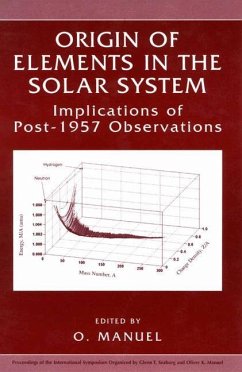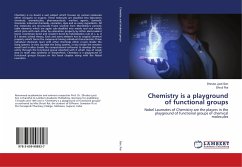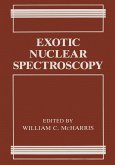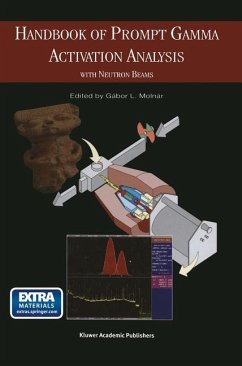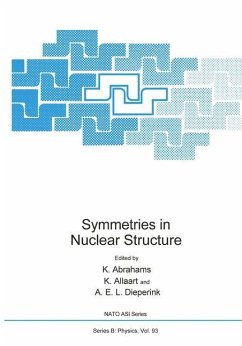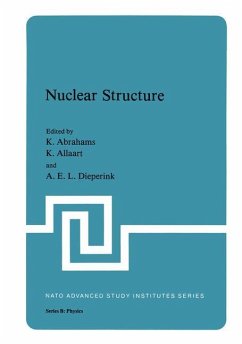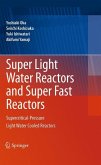Origin of Elements in the Solar System
Implications of Post-1957 Observations
Herausgegeben:Manuel, Oliver K.
Origin of Elements in the Solar System
Implications of Post-1957 Observations
Herausgegeben:Manuel, Oliver K.
- Broschiertes Buch
- Merkliste
- Auf die Merkliste
- Bewerten Bewerten
- Teilen
- Produkt teilen
- Produkterinnerung
- Produkterinnerung
Based on an American Chemical Society Symposium organized by Professors Glenn Seaborg and Oliver Manuel, this volume provides a comprehensive record of different views on this important subject at the end of the 20th century. They have assembled a blend of highly respected experimentalists and theorists from astronomy, geology, meteoritics, planetology and nuclear chemistry and physics to discuss the origin of elements in the solar system. The intent was to include all points of view and let history judge their validity.
Andere Kunden interessierten sich auch für
![Chemistry is a playground of functional groups Chemistry is a playground of functional groups]() Dhrubo Jyoti SenChemistry is a playground of functional groups55,99 €
Dhrubo Jyoti SenChemistry is a playground of functional groups55,99 €![Exotic Nuclear Spectroscopy Exotic Nuclear Spectroscopy]() William C. McHarrisExotic Nuclear Spectroscopy60,99 €
William C. McHarrisExotic Nuclear Spectroscopy60,99 €![Handbook of Prompt Gamma Activation Analysis Handbook of Prompt Gamma Activation Analysis]() Handbook of Prompt Gamma Activation Analysis149,99 €
Handbook of Prompt Gamma Activation Analysis149,99 €![Symmetries in Nuclear Structure Symmetries in Nuclear Structure]() K. AbrahamsSymmetries in Nuclear Structure41,99 €
K. AbrahamsSymmetries in Nuclear Structure41,99 €![Nuclear Structure Nuclear Structure]() K. AbrahamsNuclear Structure41,99 €
K. AbrahamsNuclear Structure41,99 €![Super Light Water Reactors and Super Fast Reactors Super Light Water Reactors and Super Fast Reactors]() Yoshiaki OkaSuper Light Water Reactors and Super Fast Reactors172,99 €
Yoshiaki OkaSuper Light Water Reactors and Super Fast Reactors172,99 €![An Introduction to Chemistry An Introduction to Chemistry]() Michael MosherAn Introduction to Chemistry76,99 €
Michael MosherAn Introduction to Chemistry76,99 €-
-
-
Based on an American Chemical Society Symposium organized by Professors Glenn Seaborg and Oliver Manuel, this volume provides a comprehensive record of different views on this important subject at the end of the 20th century. They have assembled a blend of highly respected experimentalists and theorists from astronomy, geology, meteoritics, planetology and nuclear chemistry and physics to discuss the origin of elements in the solar system. The intent was to include all points of view and let history judge their validity.
Produktdetails
- Produktdetails
- Verlag: Springer / Springer US / Springer, Berlin
- Artikelnr. des Verlages: 978-1-4757-7315-6
- 2002
- Seitenzahl: 672
- Erscheinungstermin: 18. Juli 2013
- Englisch
- Abmessung: 254mm x 178mm x 36mm
- Gewicht: 1272g
- ISBN-13: 9781475773156
- ISBN-10: 1475773153
- Artikelnr.: 39934005
- Herstellerkennzeichnung Die Herstellerinformationen sind derzeit nicht verfügbar.
- Verlag: Springer / Springer US / Springer, Berlin
- Artikelnr. des Verlages: 978-1-4757-7315-6
- 2002
- Seitenzahl: 672
- Erscheinungstermin: 18. Juli 2013
- Englisch
- Abmessung: 254mm x 178mm x 36mm
- Gewicht: 1272g
- ISBN-13: 9781475773156
- ISBN-10: 1475773153
- Artikelnr.: 39934005
- Herstellerkennzeichnung Die Herstellerinformationen sind derzeit nicht verfügbar.
Glenn Seaborg and the Quest for Superheavy Elements.- Ghiorso Remembers Seaborg.- Superheavy Elements at Berkeley: The Culmination of Seaborg's Career.- The Discovery of Superheavy Elements 107-112 and of the Deformed Shell at N = 162.- The Nuclear Reactions That Made Our Elements.- The Decay of 19N.- Measuring the Astrophysics Rate of the 21Na(p,?)22Mg Reaction.- Production and ?-Decay Half-Lives of Very N-Rich Nuclei.- The Role of the N = 28 and N = 40 Closed Shells in the Production of the Neutron-Rich Ca-Ti-Cr-Fe-Ni Elements in the Universe.- Experimental Studies Related to s-process Abundances.- Neutron Capture Cross Section Measurements for the Analysis of the s-process.- About the Reliability of Extrapolation of Nuclear Structure Data for r-process Calculations.- The Astrophysical r-process.- Nuclear Aspects of Stellar and Explosive Nucleosynthesis.- Proton Captures in the Atmosphere of Accreting Neutron Stars.- A Cosmological View of Nucleosynthesis.- The Origin of the Elements.- Chemical Evolution Tomorrow.- LiBeB Nucleosynthesis and Clues to the Chemical Evolution of the Universe.- Measurement of the 44Ti Half-life and its Significance for Supernovae.- On the Half-Life of 44Ti in Young Supernova Remnants.- Abundances in SN 1987A and Other Supernovae.- The Birth of Planetary Systems Directly from Supernovae.- Bipolar Outflows in Stellar Astrophysics.- Nuclides in the Sun.- Mini-blackhole at the Solar Center and Isotopic Abundances in the Primitive Solar Nebula.- Abundances of the Elements in the Sun.- Isotopic Ratios: The Key to Elemental Abundances and Nuclear Reactions in the Sun.- Critical Evaluation of CI Chondrites as the Solar System Standard of Elemental Abundances.- Sensitivity of Solar Oscillation Frequencies to Element Abundances.- Inverse andForward Helioseismology: Understanding the Interior Composition and Structure of the Present Sun.- Heterogeneous Accretion of the Sun and the Inner Planets.- Interstellar Matter, Sun, and the Solar system.- Nuclides in the Sun's Planetary Systems.- Isotope Anomalies in Tellurium in Interstellar Diamonds.- Isotope Abundance Anomalies in Meteorites: Clues to Yields of Individual Nucleosynthesis Processes.- Variation of Molybdenum Isotopic Composition in Iron Meteorites.- Iron Meteorites and Paradigm Shifts.- Chronology of Early Solar System Events: Dating with Short-lived Nuclides.- Xenology, FUN Anomalies and the Plutonium-244 Story.- Extinct 244Pu: Chronology of Early Solar System Formation.- A Search for Natural Pu-244 in Deep-Sea Sediment: Progress Report.- Strange Xenon Isotope Ratios in Jupiter.- Abundances of Hydrogen and Helium Isotopes in Jupiter.- The Possible Role of PeP Weak Interactions in the Early History of the Earth.- Ce-Nd-Sr Isotope Systematics of Eucrites and Lunar Rocks.- The Origin of the Solar System.- Abundance of 182Hf and the Supernova Model of the Solar System.- Binary Origin of Solar System.- Origin of Elements in the Solar System.
Glenn Seaborg and the Quest for Superheavy Elements.- Ghiorso Remembers Seaborg.- Superheavy Elements at Berkeley: The Culmination of Seaborg's Career.- The Discovery of Superheavy Elements 107-112 and of the Deformed Shell at N = 162.- The Nuclear Reactions That Made Our Elements.- The Decay of 19N.- Measuring the Astrophysics Rate of the 21Na(p,?)22Mg Reaction.- Production and ?-Decay Half-Lives of Very N-Rich Nuclei.- The Role of the N = 28 and N = 40 Closed Shells in the Production of the Neutron-Rich Ca-Ti-Cr-Fe-Ni Elements in the Universe.- Experimental Studies Related to s-process Abundances.- Neutron Capture Cross Section Measurements for the Analysis of the s-process.- About the Reliability of Extrapolation of Nuclear Structure Data for r-process Calculations.- The Astrophysical r-process.- Nuclear Aspects of Stellar and Explosive Nucleosynthesis.- Proton Captures in the Atmosphere of Accreting Neutron Stars.- A Cosmological View of Nucleosynthesis.- The Origin of the Elements.- Chemical Evolution Tomorrow.- LiBeB Nucleosynthesis and Clues to the Chemical Evolution of the Universe.- Measurement of the 44Ti Half-life and its Significance for Supernovae.- On the Half-Life of 44Ti in Young Supernova Remnants.- Abundances in SN 1987A and Other Supernovae.- The Birth of Planetary Systems Directly from Supernovae.- Bipolar Outflows in Stellar Astrophysics.- Nuclides in the Sun.- Mini-blackhole at the Solar Center and Isotopic Abundances in the Primitive Solar Nebula.- Abundances of the Elements in the Sun.- Isotopic Ratios: The Key to Elemental Abundances and Nuclear Reactions in the Sun.- Critical Evaluation of CI Chondrites as the Solar System Standard of Elemental Abundances.- Sensitivity of Solar Oscillation Frequencies to Element Abundances.- Inverse andForward Helioseismology: Understanding the Interior Composition and Structure of the Present Sun.- Heterogeneous Accretion of the Sun and the Inner Planets.- Interstellar Matter, Sun, and the Solar system.- Nuclides in the Sun's Planetary Systems.- Isotope Anomalies in Tellurium in Interstellar Diamonds.- Isotope Abundance Anomalies in Meteorites: Clues to Yields of Individual Nucleosynthesis Processes.- Variation of Molybdenum Isotopic Composition in Iron Meteorites.- Iron Meteorites and Paradigm Shifts.- Chronology of Early Solar System Events: Dating with Short-lived Nuclides.- Xenology, FUN Anomalies and the Plutonium-244 Story.- Extinct 244Pu: Chronology of Early Solar System Formation.- A Search for Natural Pu-244 in Deep-Sea Sediment: Progress Report.- Strange Xenon Isotope Ratios in Jupiter.- Abundances of Hydrogen and Helium Isotopes in Jupiter.- The Possible Role of PeP Weak Interactions in the Early History of the Earth.- Ce-Nd-Sr Isotope Systematics of Eucrites and Lunar Rocks.- The Origin of the Solar System.- Abundance of 182Hf and the Supernova Model of the Solar System.- Binary Origin of Solar System.- Origin of Elements in the Solar System.

